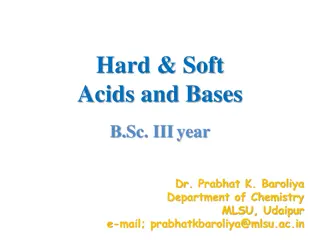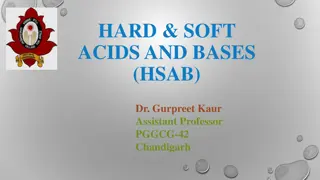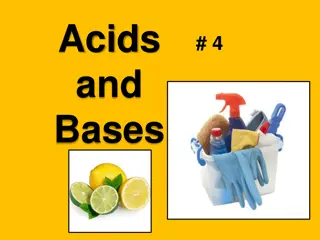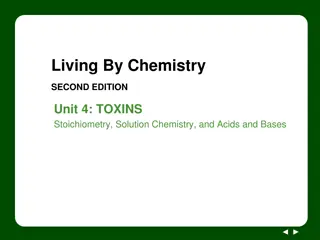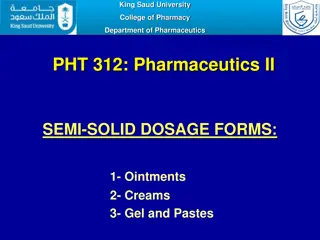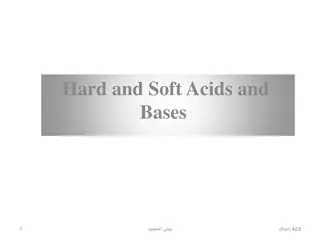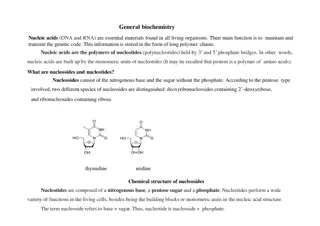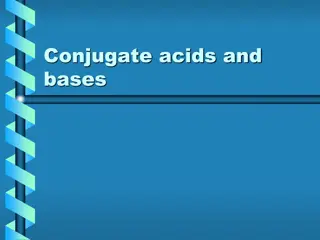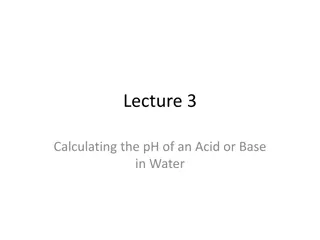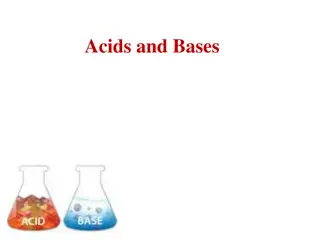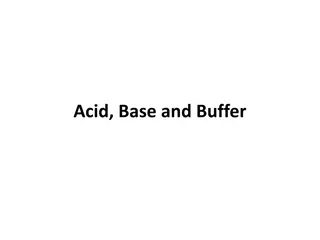Understanding Acids and Bases in Chemistry
Acids donate protons, while bases accept them. Strong acids ionize completely while weak acids only partially ionize, resulting in a Ka value less than one. Water, being amphoteric, can both donate and accept protons. The ionization of water leads to a constant Kw value of 10^-14. Explore the ionization of weak acids and bases, understanding their affinity towards protons and the relationship between their Ka values and acid strength.
Download Presentation

Please find below an Image/Link to download the presentation.
The content on the website is provided AS IS for your information and personal use only. It may not be sold, licensed, or shared on other websites without obtaining consent from the author. Download presentation by click this link. If you encounter any issues during the download, it is possible that the publisher has removed the file from their server.
E N D
Presentation Transcript
Acids and Bases acid and base
Acids and Bases Acid: is a substance that can donate protons (hydrogen ions). Base: is a substance that can accept protons.
Ionization of Strong Acids and Bases A strong acid is a substance that ionizes 100% in aqueous solutions. HCl + H2O A strong base is a substance that ionizes totally in solution to produce OH-ions. KOH H3O++ Cl- K++ OH-
Ionization of Water K1 H2O H++ OH- K-1 [H+] [OH-] [H2O] Keq = Water is amphoteric it can accept and donate protons. In pure water for every mole of [H+], a 1 mole of [OH-] is produced, ie. [H+] = [OH-] The pH of water = 7 Then: [H+] = [OH-] = 10-7 M
Ionization of Water Continue Thus the molarity of water: In 1 liter of water = 1000g of water Mw of H2O = (2*1) + (1*16) =18g/mole. No. of moles= 1000 / 18 = 55.6 moles. M = 55.6 / 1 = 55.6 molar. Since part of water molecules is ionized, the actual conc. of the water is = 55.6 -10-7 . no. of moles M = volume of solution in L
Ionization of Water continue The 10-7 is very small it can be neglected K eq = [H+] [OH-] 55.6 Since the concentration of the water is constant thus Keq of water can be written as follows: Keq = [H+] [OH-] Kw = [H+] [OH-] Kw = 10-7 10-7 Kw = 10-14 pKw = - log 10-14 pKw = 14
Ionization of Weak Acids Weak acids have a weak affinity towards their proton CH3COOH + H2O CH3COO - + H3O+ Ka = [CH3COOH] [H3O+] [CH3COO-] The concentration of water is not considered since it is a constant. Thus HA H+ + A- Ka = [H+] [A-] [HA]
Ionization of Weak Acids Continue Since weak acids ionize partially only thus, their Ka value will always be less than one because the concentration of [HA] is always higher than the concentration of both [H+] and [A-]. Between weak acids the higher the Ka the stronger the acid.
Ionization of Weak Bases Weak bases have a weak affinity towards their proton. NH4OH NH4 + + OH- [NH4 +] [OH-] [NH4OH] Kb =
pH of Solutions of Weak Acids The dissociation of a weak monoprotic acid, HA, yields, H+ and A- in equal concentration. If Ka and the initial concentration of HA are known, H+ can be calculated easily: Ka = = [H+] 2 =Ka [HA] [H+] = Ka [HA] Log[H+] = Log Ka [HA] [H+] [A-] [HA] [H+] 2 [HA]
pH of Solutions of Weak Acids Continue Multiply by -1 - Log[H+] = (-Log Ka - Log [HA]) pH = ( pKa + p [HA]) A similar relationship can be derived for weak bases: [OH-] = Kb [A-] pOH = ( pKb + p [A-])
Relationship Between pKa and pKb for Weak Acids and Bases Kw=Ka*Kb pKw =pka + pKb pKw =pH + pOH
Example A weak acid HA, is 0.1% ionized (dissociated) in a 0.2 M solution. a) What is the equilibrium constant of the acid Ka? b) What is the pH of the solution? c) How many ml of 0.1 N KOH would be required to neutralize completely 500 ml of 0.2 M HA solution?
Example Continue A) Start: HA 0.2 M H+ + 0 A- 0 The dissociation fraction= (0.1/100) * 0.2 = 2 10-4 M Equilibrium: 0.2-2 10-4 M 2 10-4 M 2 10-4 M Ka = Ka = ((2 10-4) (2 10-4)) / 0.2-2 10-4 [H+] [A-] [HA] When the amount of HA that has dissociated is small, 10% or less the Ka is simplified by ignoring the subtraction from [HA]
Example Continue Ka = ((2 10-4) (2 10-4)) / 0.2 Ka = 4 10-8 / 2 10-1 Ka = 2 10-7 B) pH = - Log [H+] pH = - Log 2 10-4 pH = 3.7 C) No. of moles of OH- required = no. of moles of H+ present Lacid Nacid = Lbase Nbase N = M 0.5 0.2 = Lbase 0.1 Lbase = 0.1/ 0.1 = 1 liter



